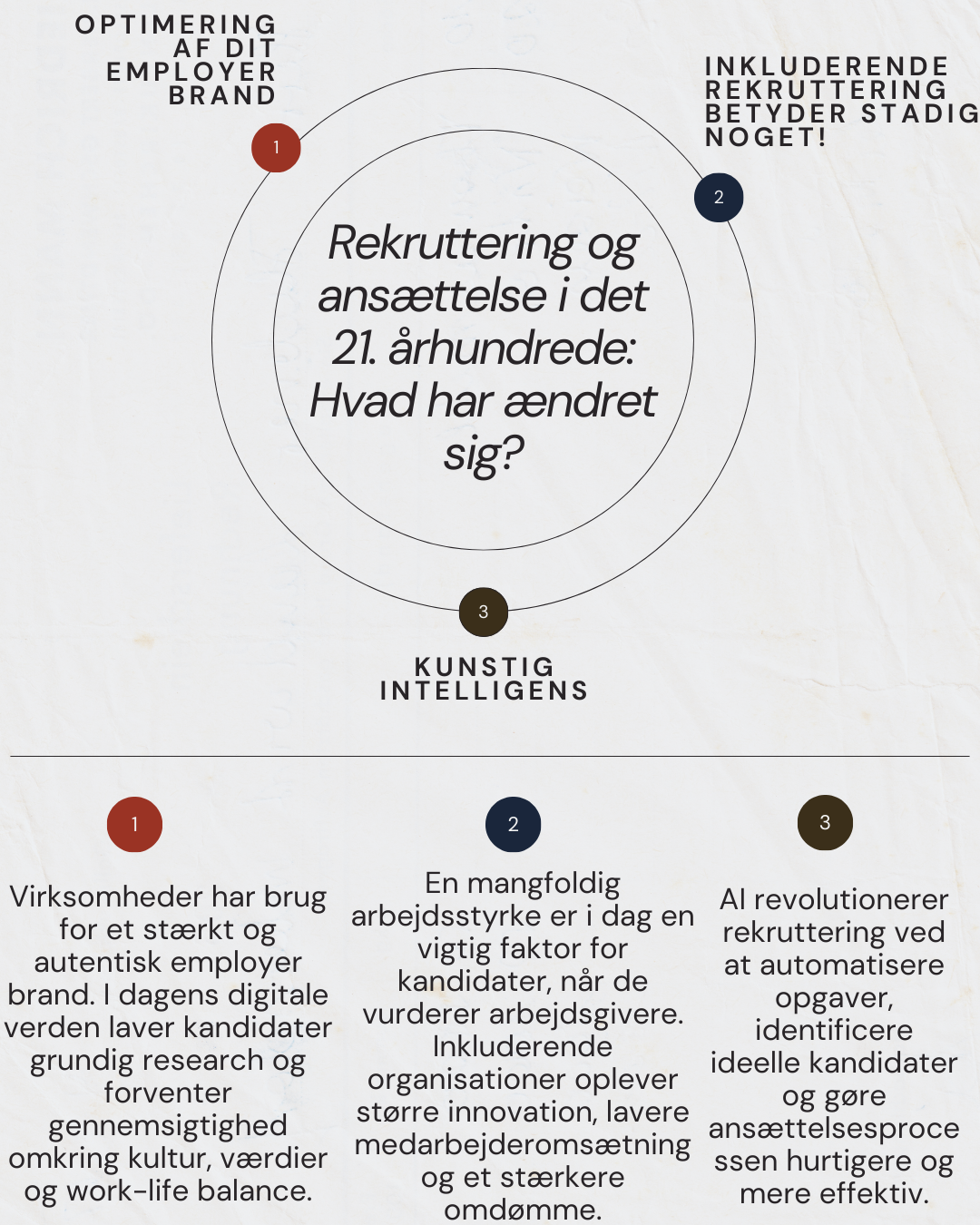Den digitale revolution har forandret rekruttering, som vi kender det. På bare et årti har vi set et markant skifte væk fra traditionelle jobportaler til en innovativ verden af nye rekrutteringsværktøjer og -metoder. For at kunne lykkes med rekruttering i dag er det afgørende, at HR-professionelle omfavner de teknologiske fremskridt fuldt ud. Rekruttering bliver i stigende grad brand-orienteret, og et stærk employer brand er nu helt essentiel for både at tiltrække og fastholde toptalenter. Men hvad betyder alle disse ændringer egentlig for rekrutteringen i den digitale tidsalder? Det ser vi nærmere på i denne artikel.
Rekruttering og ansættelse i det 21. århundrede – hvad har ændret sig?
I takt med at samfundet i det 21. århundrede fortsætter med at udvikle sig, og holdninger ændrer sig, er det afgørende, at virksomheder er opmærksomme på medarbejdernes skiftende behov og forventninger. Tiden, hvor medarbejdere blev i den samme virksomhed i 30 år – eller endda i mere end 5 år – er stort set forbi. Nye generationer træder ind på arbejdsmarkedet og søger mere varierede erfaringer, kortere ansættelser og fleksible, adaptive arbejdsmiljøer. Faktisk har de yngre generationer fået ry af at være langt mere tilbøjelige til jobskifte, særligt millennials. Denne generation siges at være mindre loyale over for organisationer og institutioner og skifter oftere arbejdsplads end nogen tidligere generation. En nylig rapport fra Gallup viser, at 21 % af millennials har skiftet job inden for det seneste år – hvilket er mere end tre gange så mange som blandt ikke-millennials.
For ikke blot at tiltrække unge generationer til en virksomhed, men også at kunne fastholde dem, er det afgørende at have et stærkt employer brand i fokus under rekrutterings- og ansættelsesprocesserne. Derudover er det vigtigt at arbejde med inkluderende rekrutteringsmetoder – og at overveje, hvordan kunstig intelligens (AI) kan hjælpe rekrutteringsarbejdet, blandt andet ved at mindske de bias-fejl, vi som mennesker kan begå, når vi ansætter. Lad os se nærmere på alle tre områder i det følgende.

Optimering af dit Employer Brand
For at tiltrække og fastholde de bedste talenter er det vigtigt, at offentlighedens opfattelse af din virksomhed er positiv. Dit employer brand svarer i bund og grund til dit ry som arbejdsgiver – og et dårligt image kan i høj grad påvirke din evne til at rekruttere og ansætte effektivt. Arbejdsgivere på tværs af brancher har derfor i stigende grad fokus på deres employer brand for at forstå, hvordan de bliver opfattet online, og hvordan denne opfattelse påvirker rekruttering, ansættelse, fastholdelse og meget mere.
Tidligere kunne virksomheder slippe afsted med – eller i det mindste minimere – en dårlig offentlig opfattelse gennem taktisk markedsføring og strategiske PR-kampagner. Men i dagens digitale verden kan ingen virksomheder undslippe negative medarbejder-anmeldelser. Kandidater researcher mere end nogensinde før, inden de søger en stilling, så det er afgørende, at virksomhedens online tilstedeværelse fortæller en positiv historie. Faktisk benytter moderne kandidater i gennemsnit 16 forskellige researchværktøjer under jobsøgningen. Det vigtigste resultat af at have et stærkt employer brand er, at potentielle medarbejdere i højere grad vil overveje din virksomhed, når de søger job. Ifølge Glassdoor angav 86 % af de adspurgte HR-professionelle, at rekruttering i stigende grad minder om markedsføring. Efter at have set nærmere på, hvorfor employer branding er så vigtig i rekrutteringsprocessen, så lad os se nærmere på, hvordan man skaber et effektivt employer brand.
Først og fremmest skal du skabe en fængende brand-fortælling. Kommunikation og gennemsigtighed er helt afgørende: Kommuniker virksomhedens kerneværdier, og vær åben og autentisk omkring jeres kultur. Potentielle medarbejdere ønsker ikke at starte i en virksomhed uden indsigt i, hvad de går ind til, så giv så meget relevant og nyttig information som muligt. Sæt dig i medarbejderens sted: Hvad ville du gerne vide, hvis du søgte en stilling? Ud over selve jobbeskrivelsen er det vigtigt at give en grundig beskrivelse af, hvordan det er at arbejde i virksomheden.
- Hvad er virksomhedens mission, vision, værdier og kultur?
- Hvilke muligheder for læring og udvikling tilbyder virksomheden medarbejderne?
- Hvilken form for work-life balance, fleksibilitet, personalegoder og ferieordning tilbyder virksomheden?
- Tilbyder virksomheden mulighed for omsorgsdage og/eller personlige fridage?
- Hvad er virksomhedens politik for hjemmearbejde / fjernarbejde?
Gennemsigtighed er her helt afgørende. Jobsøgere bliver i stigende grad mere opmærksomme på falske løfter – så hvis din virksomhed fremhæver ubegrænset ferie, men medarbejder anmeldelser peger på en kultur, hvor man bliver straffet for at tage fri, vil det hurtigt blive tydeligt, at virksomheden ikke fortæller den sande historie.
Udnyt den digitale verdens muligheder til at skabe opmærksomhed omkring din virksomheds bedste sider gennem blogs, vlogs, opslag på sociale medier og andet indhold om jeres medarbejdere, historie og succeser. Husk også, at medarbejder anmeldelser og -udtalelser er en afgørende faktor, når kandidater beslutter sig for at søge en stilling eller acceptere et jobtilbud – så vær opmærksom på, hvordan medarbejdere vurderer virksomheden, og træf medarbejder centrerede beslutninger, der minimerer klager og fremmer en positiv medarbejderoplevelse. En undersøgelse fra iCIMS med titlen “The Modern Job Seeker” viser, at næsten 1 ud af 3 arbejdstagere har takket nej til et jobtilbud primært på grund af negative online anmeldelser af arbejdsgiveren – og tallet er endnu højere blandt millennials, hvor 47% har afvist et jobtilbud på grund af dårlige anmeldelser online.
Inkluderende rekruttering betyder stadig noget!
Nye generationer har bragt en stigende interesse for DEI (diversitet, lighed og inklusion) med sig, og virksomheder følger trop. Faktisk angiver 76% af medarbejdere og jobsøgende, at en mangfoldig arbejdsstyrke er en vigtig faktor, når de vurderer virksomheder og jobtilbud – og dette gælder især for sorte, hispaniske og LGBTQ+-jobsøgende og medarbejdere. DEI handler om talent – at kunne tiltrække, udvikle og fastholde medarbejdere samt skabe en kultur og strukturer med lige vilkår baseret på bæredygtigt, inkluderende lederskab. DEI-praksisser er ikke kun afgørende fra et rekrutterings perspektiv, men også set ud fra et organisatorisk synspunkt:
- Virksomheder med højere grad af kønsdiversitet og med HR-politikker og -praksisser, der fokuserer på kønsdiversitet, har lavere medarbejderomsætning.
- 35% af en medarbejders følelsesmæssige engagement i arbejdet og 20% af lysten til at blive i organisationen er knyttet til følelsen af tilhørsforhold og inklusion.
- Ifølge en nyere undersøgelse tjente virksomheder med større mangfoldighed i ledelsen over en periode på tre år i gennemsnit 38% mere af deres omsætning på innovative produkter og services sammenlignet med virksomheder med lavere diversitet.
- Organisationer med inkluderende forretningskulturer og -praksisser har 57,8% større sandsynlighed for at forbedre deres omdømme.
Statistikkerne taler for sig selv, men hvordan kan virksomheder implementere reelt effektive inklusionspolitikker i deres rekrutteringsprocesser?
Lad os starte med det grundlæggende – de kanaler, hvorigennem virksomheden rekrutterer, bør være mangfoldige og inkludere diversitet fokuserede ressourcer (som LinkedIn Diversity Groups), konferencer, universiteter og jobportaler. For det andet er det essentielt at være opmærksom, når man laver jobbeskrivelserne. I mange organisationer er det de ansættende ledere, der skriver jobopslagene, men de er ikke nødvendigvis uddannede i at anvende inkluderende sprogbrug. Sprog har en stor indflydelse på, hvilke kandidater – og hvilket køn – man tiltrækker og fastholder. For eksempel tiltrækker udtryk som ”dokumenteret” og ”arbejdspres” i jobopslag oftere mandlige kandidater. Ifølge forskning fra Textio – en AI-drevet skriveforbedringsservice – får virksomheder, der anvender kønsneutrale jobbeskrivelser, et bredere ansøgerfelt, og stillingen bliver besat tre uger hurtigere end stillinger med kønspræget sprogbrug. Når du skriver jobopslag, så sørg for at gøre det med et inkluderende perspektiv og vær opmærksom på nuancer i kønsbestemt sprog. Disse subtile justeringer kan gøre en stor forskel i arbejdet med at tiltrække en mangfoldig arbejdsstyrke.
Desuden, når du taler om “kulturelt match” i rekrutteringsprocessen, skal du sørge for at gøre det på en måde, der inkluderer – fremfor ekskluderer – individet. I stedet for at forsøge at få din potentielle medarbejder til at passe ind i en “one size fits all”-model, bør du tænke på deres individualitet, og hvad de kan tilføre virksomhedens kultur. Personligt foretrækker jeg udtrykket kulturel berigelse fremfor kulturelt match – da det er mere inkluderende.
Sådan bruger du kunstig intelligens i rekrutteringsprocessen
AI til rekruttering transformerer talent anskaffelsesprocessen ved at anvende maskinlæring og kunstig intelligens til at identificere ideelle kandidater og automatisere manuelle, gentagne opgaver. Denne teknologiske innovation effektiviserer forskellige dele af rekrutterings arbejdet og gør AI uundværlig i moderne rekrutteringsstrategier. Forbes har eksempelvis fremhævet AIs markante indflydelse på rekruttering og understreget dens evne til at lette byrden ved denne udfordrende opgave ved at forenkle lange processer.
Vigtige AI-værktøjer i rekruttering
Chatbots: Giver hurtig adgang til kandidater og guider dem til relevante roller, håndterer effektivt store mængder ansøgere og sparer betydelig tid.
Sentiment Analysis: Hjælper med at justere jobbeskrivelser for at undgå forudindtaget eller uindbydende sprogbrug og fremmer en mere inkluderende rekrutteringsproces.
Talent Rediscovery: Udnytter Applicant Tracking Systems (ATS) til at gennemgå eksisterende data og identificere tidligere oversete kandidater, som nu måske opfylder jobkravene.
Andre overvejelser omkring AI
Når virksomheder tager AI-drevne værktøjer i brug, er det vigtigt samtidig at indtænke etiske overvejelser i AI-strategien. Det er afgørende at vælge AI-teknologier og leverandører, der er overholder etiske forskrifter, for at sikre, at disse værktøjer fremmer retfærdighed og gennemsigtighed i rekrutteringsprocesserne. Derudover er det altafgørende at tage hensyn til privatliv bekymringer; AI-applikationer skal overholde globale databeskyttelsesregler for at beskytte kandidat oplysninger.
Et andet vigtigt aspekt er den omhyggelige balance mellem at udnytte AI og bevare den menneskelige involvering i rekrutteringen. En overdreven afhængighed af teknologi risikerer at fjerne den personlige tilgang, som er afgørende for at forstå en kandidats unikke egenskaber og potentielle match med virksomhedens kultur. Derfor bør AI supplere – og ikke erstatte – den menneskelige dømmekraft i ansættelsesbeslutninger.
Derudover giver AI en stærk mulighed for at reducere bias i rekrutteringsprocessen. Ved at anvende algoritmer, der er trænet på forskellige datasæt og løbende overvåger for bias, kan AI hjælpe med at sikre en mere retfærdig vurdering af kandidater baseret på deres kompetencer og erfaring fremfor ubevidste fordomme relateret til deres baggrund eller identitet. Denne tilgang gør ikke kun ansættelsesprocessen mere retfærdig, men hjælper også organisationer med at opbygge en mere mangfoldig og inkluderende arbejdsstyrke.
Afslutningsvis kræver udnyttelsen af AI i rekruttering en mangefacetteret tilgang, der inkluderer etiske overvejelser, beskyttelse af privatliv, en balance mellem teknologi og menneskelig interaktion samt en forpligtelse til at reducere bias. Ved på en gennemtænkt måde at integrere AI-værktøjer inden for disse retningslinjer kan rekrutteringsansvarlige og HR-professionelle forbedre effektiviteten, retfærdigheden og inklusionen i deres rekrutteringsprocesser, hvilket i sidste ende fører til en mere dynamisk og mangfoldig arbejdsplads.
Hvorfor er “rekruttering” blevet til “talent acquisition”? Og hvad er egentlig forskellen?
I de senere år er der sket et skifte hen mod det, man kalder “talent acquisition”, men hvad er det egentlig, og hvordan adskiller det sig fra traditionel rekruttering? Det kan siges helt enkelt:
Rekruttering handler traditionelt om at udfylde ledige stillinger, mens talent acquisition er en løbende strategi for at tiltrække, ansætte og fastholde talenter til din virksomhed.
Så hvad bør din virksomhed fokusere på – talent acquisition eller rekruttering? Kort sagt afhænger det af organisationens behov. For eksempel bør virksomheder, der har brug for nye og højt efterspurgte kompetencer, fx inden for IT og teknologi, koncentrere sig om talent acquisition. Sharon Koifman, grundlægger og CEO af DistantJob, et rekrutteringsfirma specialiseret i at placere virtuelle medarbejdere, udtaler:
“Med den hurtige teknologiske udvikling og fremkomsten af højt specialiserede tech-relaterede job, kan man med sikkerhed sige, at IT- og tech-branchen har langt større behov for en stærk talent acquisition-strategi end andre brancher.”
Andre mener, at alle brancher bør fokusere på talent acquisition fremfor traditionel rekruttering, fordi talent acquisition skaber en stærkere virksomhed, fremmer teamwork og øger produktiviteten. Mens rekruttering fortsat er en vigtig aktivitet for at udfylde akutte ledige stillinger, er talent acquisition en langsigtet strategi, der gør ansættelsesprocessen både mere effektiv og mere produktiv.Konklusion
Konklusion
Jeg håber, at de pointer, der er fremlagt i denne artikel, kan hjælpe dig med rekruttering anno det 21. århundrede! Rekruttering og talent acquisition er den vigtigste faktor til at fremtidssikre din organisation.En sammenhængende rekrutterings- og talent acquisition-strategi er afgørende for at kunne tiltrække og fastholde fremtidens arbejdsstyrke.









